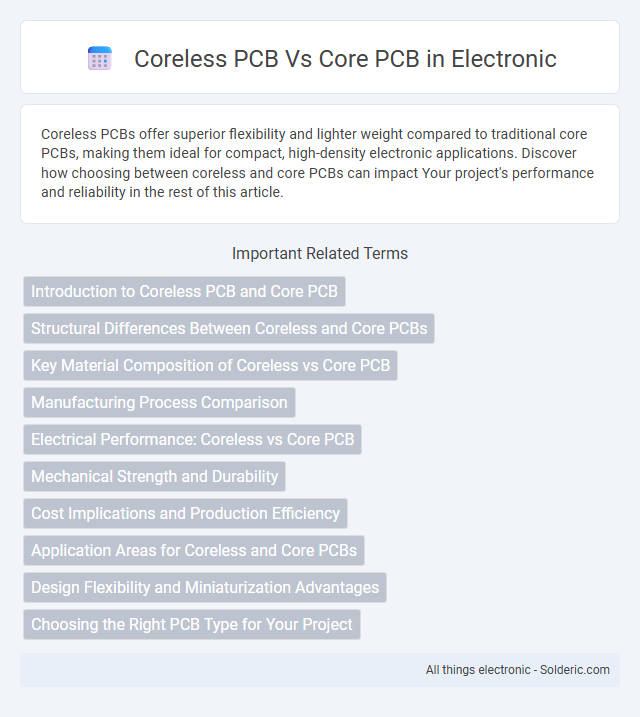Coreless PCBs offer superior flexibility and lighter weight compared to traditional core PCBs, making them ideal for compact, high-density electronic applications. Discover how choosing between coreless and core PCBs can impact Your project's performance and reliability in the rest of this article.
Comparison Table
| Feature | Coreless PCB | Core PCB |
|---|---|---|
| Substrate | No rigid core; uses thin prepreg or dielectric layers | Rigid fiberglass epoxy core (FR4) |
| Thickness | Ultrathin, typically below 100 um | Standard thickness, typically 0.8 - 1.6 mm |
| Flexibility | Highly flexible and bendable | Rigid and less flexible |
| Application | Flexible circuits, wearable devices, lightweight electronics | Rigid applications, standard electronics, multilayer boards |
| Signal Integrity | Better for high-frequency signals due to thinner dielectric | Good but limited by core thickness and material |
| Manufacturing Complexity | Higher; requires precision handling | Lower; established processes |
| Cost | Higher due to advanced materials and process | Lower; mass production efficient |
| Thermal Management | Less efficient heat dissipation | Better thermal stability and dissipation |
Introduction to Coreless PCB and Core PCB
Coreless PCBs eliminate the traditional rigid core, resulting in a thinner, more flexible circuit board ideal for compact electronic devices like smartphones and wearable gadgets. Core PCBs use a solid substrate made from materials such as FR4, providing structural stability and durability for applications in automotive and industrial electronics. Understanding the distinction helps ensure your choice aligns with performance requirements and design constraints.
Structural Differences Between Coreless and Core PCBs
Coreless PCBs lack the traditional rigid core, instead relying on a thin dielectric material that significantly reduces thickness and weight compared to Core PCBs, which have a solid fiberglass core for mechanical strength and stability. The absence of a core layer in coreless PCBs allows for improved electrical performance and better heat dissipation, while core PCBs typically offer enhanced durability for high-stress environments. Your choice between coreless and core PCB depends on the specific application requirements involving flexibility, size constraints, and thermal management.
Key Material Composition of Coreless vs Core PCB
Coreless PCBs utilize a thin dielectric material without a rigid core, enhancing flexibility and reducing overall thickness, while Core PCBs feature a rigid fiberglass-reinforced epoxy resin layer known as FR4, providing structural support and durability. The absence of the core in Coreless PCBs minimizes signal distortion and improves electrical performance, making them ideal for high-frequency applications. Your choice between Coreless and Core PCBs depends on the specific material composition requirements related to flexibility, weight, and signal integrity.
Manufacturing Process Comparison
Coreless PCBs eliminate the traditional fiberglass core layer, resulting in a thinner, lighter, and more flexible circuit board fabricated through a sequential lamination process that builds up layers without a rigid core. Core PCBs incorporate a solid fiberglass core, manufactured by laminating copper foil onto a rigid substrate, providing structural stability but increasing thickness and weight. Your choice between coreless and core PCB manufacturing processes impacts board flexibility, thermal performance, and potential application in miniaturized electronic devices.
Electrical Performance: Coreless vs Core PCB
Coreless PCBs exhibit superior electrical performance due to reduced dielectric thickness, which results in lower signal loss and improved high-frequency signal integrity compared to Core PCBs. The absence of a rigid core in Coreless PCBs minimizes parasitic capacitance and inductance, enhancing signal speed and reducing crosstalk. Conversely, Core PCBs provide better mechanical stability but may suffer from higher signal attenuation and slower transmission speeds in high-frequency applications.
Mechanical Strength and Durability
Coreless PCBs offer superior mechanical flexibility but generally lower mechanical strength compared to Core PCBs, which contain a rigid dielectric core providing enhanced structural durability. The solid core in Core PCBs improves resistance to bending, warping, and mechanical stress, making them better suited for applications requiring robust, long-lasting circuit boards. Your choice should consider the mechanical demands of your device, favoring Core PCBs for durability and Coreless PCBs for lightweight, flexible designs.
Cost Implications and Production Efficiency
Coreless PCBs typically reduce material costs by eliminating the traditional fiberglass core, resulting in thinner, lighter, and more flexible circuit boards suitable for compact electronic devices. Production efficiency improves due to shorter etching and lamination times, though manufacturing complexity can increase initial setup expenses. Conversely, core PCBs offer greater structural stability and simpler fabrication processes, which can lead to lower per-unit costs in large-scale production but higher overall material expenses.
Application Areas for Coreless and Core PCBs
Coreless PCBs are predominantly used in high-density, compact electronic devices such as smartphones, medical implants, and wearable technology, where miniaturization and flexibility are critical. Core PCBs find wide applications in automotive electronics, industrial machinery, and consumer electronics requiring robust mechanical strength and thermal stability. Both types serve distinct roles, with coreless PCBs excelling in advanced, space-constrained designs and core PCBs preferred for durability and high-power applications.
Design Flexibility and Miniaturization Advantages
Coreless PCBs offer superior design flexibility and miniaturization advantages compared to core PCBs due to their lack of a rigid central core, enabling thinner, lighter, and more complex multi-layer circuits. This structure supports higher density interconnects and greater electrical performance, making coreless PCBs ideal for advanced applications such as wearable electronics and high-frequency devices. Core PCBs, constrained by their rigid core, limit design innovation and miniaturization potential, often resulting in bulkier circuit boards less suited for space-critical technologies.
Choosing the Right PCB Type for Your Project
Coreless PCBs offer a thinner, lighter design ideal for high-frequency and miniaturized electronics, while Core PCBs provide robustness and stability suitable for multi-layer and high-power applications. Your choice depends on project requirements such as size constraints, thermal management, and signal integrity. Understanding these differences ensures optimal performance and reliability in your electronic designs.
Coreless PCB vs Core PCB Infographic

 solderic.com
solderic.com